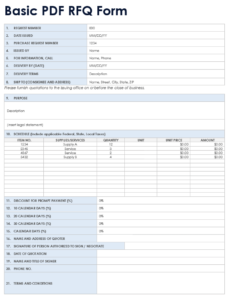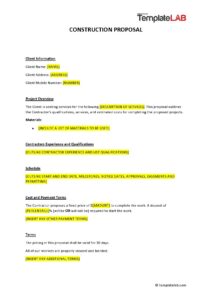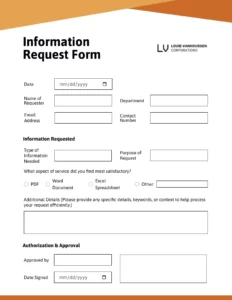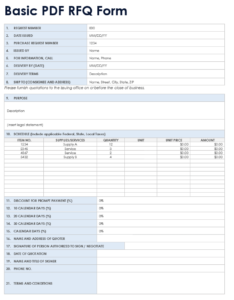Utilizing a predefined structure for price inquiries offers numerous advantages. It saves time and resources by providing vendors with a clear understanding of requirements. This clarity leads to more accurate and competitive bids, enabling better decision-making. Furthermore, a standardized approach promotes fairness and transparency in vendor selection, ultimately contributing to more efficient and cost-effective procurement.
This foundation of understanding regarding structured price requests allows for deeper exploration of related topics, such as creating effective templates, best practices for distribution and response collection, and strategies for evaluating vendor proposals. The following sections will delve into these areas, providing practical guidance for optimizing the procurement cycle.
Key Components of a Formal Price Request
Effective price requests require specific information to ensure clarity and facilitate accurate responses. The following components constitute a comprehensive and effective document.
1: Clear Identification of the Requesting Organization: Including the full legal name, address, and contact information ensures vendors can readily identify the source of the request.
2: Detailed Specification of Required Goods or Services: Precise descriptions, including quantities, units of measure, and relevant technical specifications, are crucial for vendors to provide accurate pricing.
3: Expected Delivery or Completion Timeframe: Clearly stating desired delivery dates or project completion timelines allows vendors to assess feasibility and factor lead times into their pricing.
4: Payment Terms and Conditions: Specifying payment methods, schedules, and any associated terms helps vendors understand payment expectations and incorporate them into their proposals.
5: Submission Instructions and Deadline: Providing clear instructions on how and when to submit proposals, including required formats and contact information, streamlines the response process.
6: Specific Requirements for the Proposal Format: Defining the required structure and content of vendor proposals ensures consistency and facilitates easy comparison across bids.
7: Point of Contact for Inquiries: Designating a specific individual or department for inquiries allows vendors to address questions and clarify any uncertainties promptly.
A well-structured request, encompassing these elements, enables vendors to provide accurate and competitive pricing, leading to informed procurement decisions. This meticulous approach promotes transparency and efficiency throughout the process.
How to Create a Request for Pricing Template
Developing a standardized template for requesting pricing ensures consistency, clarity, and efficiency in procurement processes. The following steps outline the creation of a comprehensive and effective template.
1: Define the Scope: Clearly identify the purpose of the template and the types of goods or services it will cover. This initial step ensures the template remains focused and relevant to specific procurement needs.
2: Establish Essential Fields: Incorporate fields for essential information, including company identification, contact details, required goods or services specifications, desired quantities, delivery timelines, and payment terms. These elements ensure vendors receive comprehensive information for accurate pricing.
3: Standardize Formatting: Utilize a consistent format for headings, subheadings, fonts, and spacing to enhance readability and professionalism. A clear and organized structure facilitates efficient processing and review.
4: Incorporate Clear Instructions: Provide explicit instructions for vendors on how to complete the template, submit proposals, and address inquiries. Clear guidance minimizes confusion and ensures consistent responses.
5: Include a Section for Vendor Information: Dedicate a section for vendors to provide their company details, contact information, and relevant certifications. This facilitates easy identification and communication.
6: Develop a Version Control System: Implement a version control system to track revisions and ensure all stakeholders utilize the most current template. This practice maintains consistency and prevents errors arising from outdated versions.
7: Test and Refine: Before widespread implementation, pilot test the template with a small group of vendors to gather feedback and identify areas for improvement. Refinement based on practical application ensures optimal functionality.
A well-designed template facilitates streamlined communication, reduces ambiguity, and promotes informed decision-making in procurement. Consistent application of such a template strengthens vendor relationships and contributes to overall procurement efficiency.
Standardized documents for soliciting pricing information play a crucial role in effective procurement. From ensuring clarity in communication to facilitating accurate comparisons and informed decision-making, a well-structured approach offers significant advantages. Key components such as detailed specifications, clear timelines, and structured response formats contribute to a streamlined process. Developing and implementing a robust template, complete with version control and continuous refinement, further optimizes efficiency and fosters stronger vendor relationships.
Organizations seeking to enhance their procurement processes should prioritize the development and consistent utilization of these structured documents. Embracing this best practice promotes transparency, fairness, and cost-effectiveness, ultimately contributing to a more robust and competitive procurement function prepared for future challenges and opportunities.



